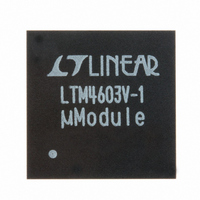LTM4603IV-1#PBF Linear Technology, LTM4603IV-1#PBF Datasheet - Page 14

LTM4603IV-1#PBF
Manufacturer Part Number
LTM4603IV-1#PBF
Description
IC DC/DC UMODULE 6A 118-LGA
Manufacturer
Linear Technology
Series
µModuler
Type
Point of Load (POL) Non-Isolatedr
Datasheet
1.LTM4603EV-1PBF.pdf
(24 pages)
Specifications of LTM4603IV-1#PBF
Design Resources
LTM4603-1 Spice Model
Output
0.6 ~ 5 V
Number Of Outputs
1
Power (watts)
30W
Mounting Type
Surface Mount
Voltage - Input
4.5 ~ 20V
Package / Case
118-LGA
1st Output
0.6 ~ 5 VDC @ 6A
Size / Dimension
0.59" L x 0.59" W x 0.11" H (15mm x 15mm x 2.8mm)
Power (watts) - Rated
30W
Operating Temperature
-40°C ~ 85°C
Efficiency
93%
Lead Free Status / RoHS Status
Lead free / RoHS Compliant
3rd Output
-
2nd Output
-
Available stocks
Company
Part Number
Manufacturer
Quantity
Price
LTM4603/LTM4603-1
APPLICATIONS INFORMATION
to the rising edge of the external clock. The frequency
range is ±30% around the operating frequency of 1MHz.
A pulse detection circuit is used to detect a clock on the
PLLIN pin to turn on the phase lock loop. The pulse width
of the clock has to be at least 400ns and 2V in amplitude.
During the start-up of the regulator, the phase-lock loop
function is disabled.
INTV
An internal low dropout regulator produces an internal
5V supply that powers the control circuitry and DRV
for driving the internal power MOSFETs. Therefore, if
the system does not have a 5V power rail, the LTM4603
can be directly powered by Vin. The gate driver current
through the LDO is about 20mA. The internal LDO power
dissipation can be calculated as:
The LTM4603 also provides the external gate driver volt-
age pin DRV
recommended to connect DRV
rail. This is especially true for higher input voltages. Do
not apply more than 6V to the DRV
be used to power the DRV
as shown in Figure 16.
Parallel Operation of the Module
The LTM4603 device is an inherently current mode con-
trolled device. Parallel modules will have very good current
14
P
3.5
3.0
2.0
1.5
1.0
2.5
0.5
0
LDO_LOSS
CC
0
and DRV
1
Figure 7. 1.5V Power Loss
CC
2
= 20mA • (V
LOAD CURRENT (A)
. If there is a 5V rail in the system, it is
CC
3
Connection
20V LOSS
4
IN
5
CC
12V LOSS
– 5V)
5V LOSS
pin with an external circuit
6
CC
4603 F07
CC
pin to the external 5V
7
pin. A 5V output can
3.5
3.0
2.5
2.0
1.5
1.0
0.5
0
0
1
Figure 8. 3.3V Power Loss
2
CC
LOAD CURRENT (A)
3
sharing. This will balance the thermals on the design. The
voltage feedback equation changes with the variable n as
modules are paralleled:
n is the number of paralleled modules.
Thermal Considerations and Output Current Derating
The power loss curves in Figures 7 and 8 can be used
in coordination with the load current derating curves in
Figures 9 to 12, and Figures 13 to 14 for calculating an
approximate θ
methods. Thermal models are derived from several tem-
perature measurements at the bench and thermal modeling
analysis. Thermal Application Note 103 provides a detailed
explanation of the analysis for the thermal models and the
derating curves. Tables 3 and 4 provide a summary of the
equivalent θ
θ
and are improved with air fl ow. The case temperature is
maintained at 100°C or below for the derating curves.
This allows for 4W maximum power dissipation in the
total module with top and bottom heatsinking, and 2W
power dissipation through the top of the module with an
approximate θ
to a total of 124°C at the junction of the device.
20V LOSS
JA
4
V
parameters are correlated to the measured values,
OUT
5
12V LOSS
=
6
0 6
4603 F08
.
JA
V
JA
JC
for the noted conditions. These equivalent
7
60 4
for the module with various heat sinking
between 6°C/W to 9°C/W. This equates
n
.
R
k
FB
+
6
5
4
3
2
1
0
R
75
FB
Figure 9. No Heat Sink 5V
5V
5V
5V
AMBIENT TEMPERATURE (°C)
IN
IN
IN
80
, 1.5V
, 1.5V
, 1.5V
OUT
OUT
OUT
, 0LFM
, 200LFM
, 400LFM
85
90
IN
4603 F09
4603fa
95















